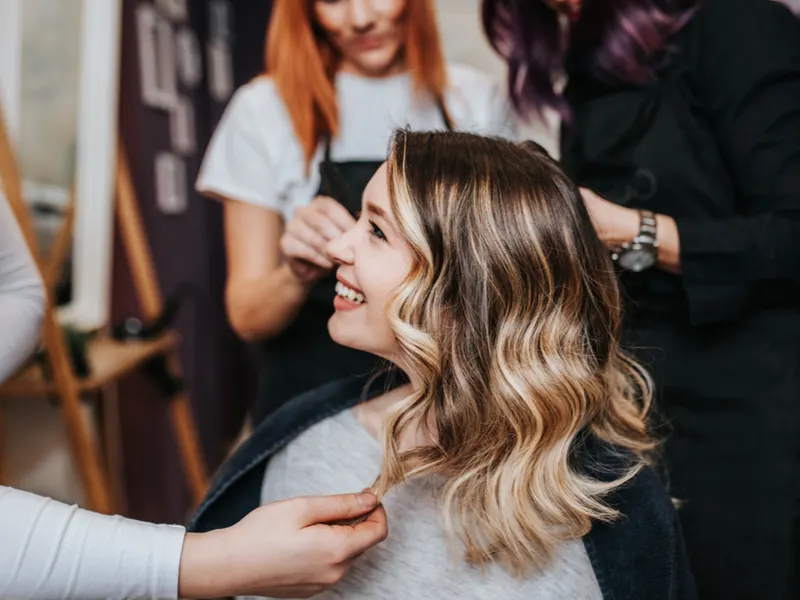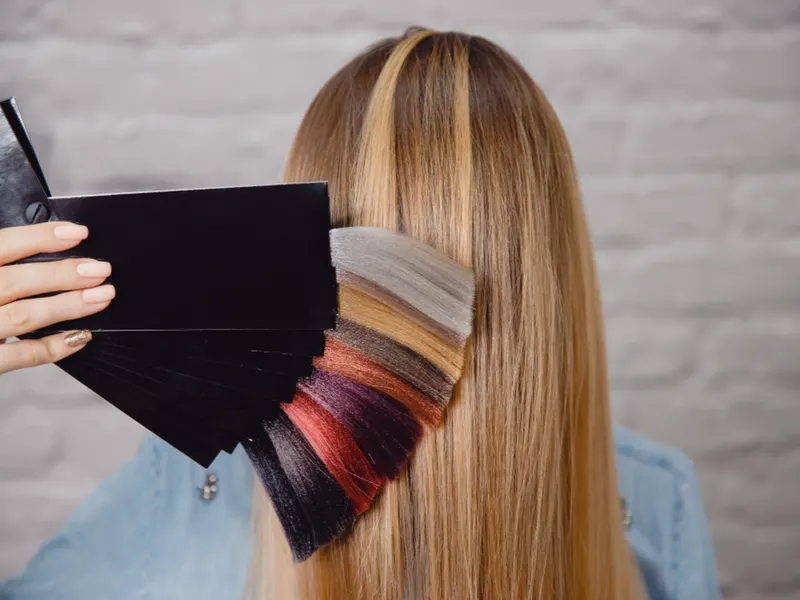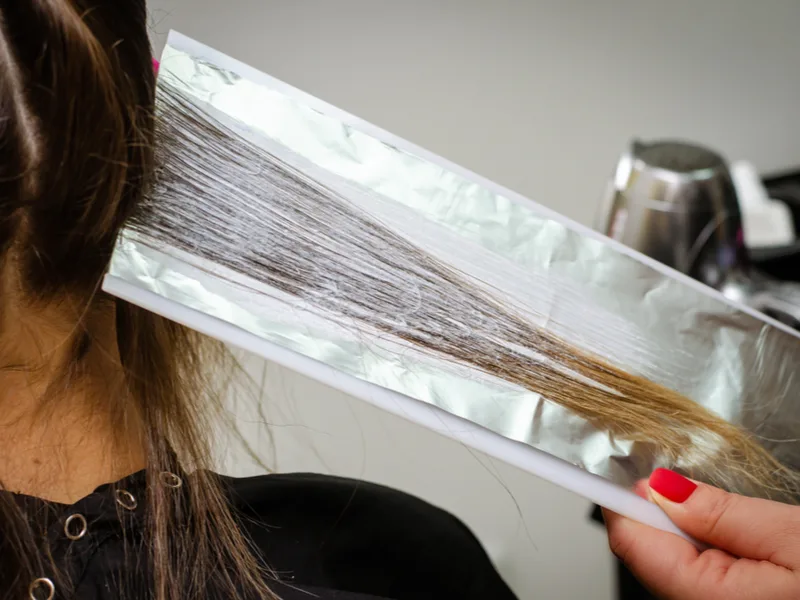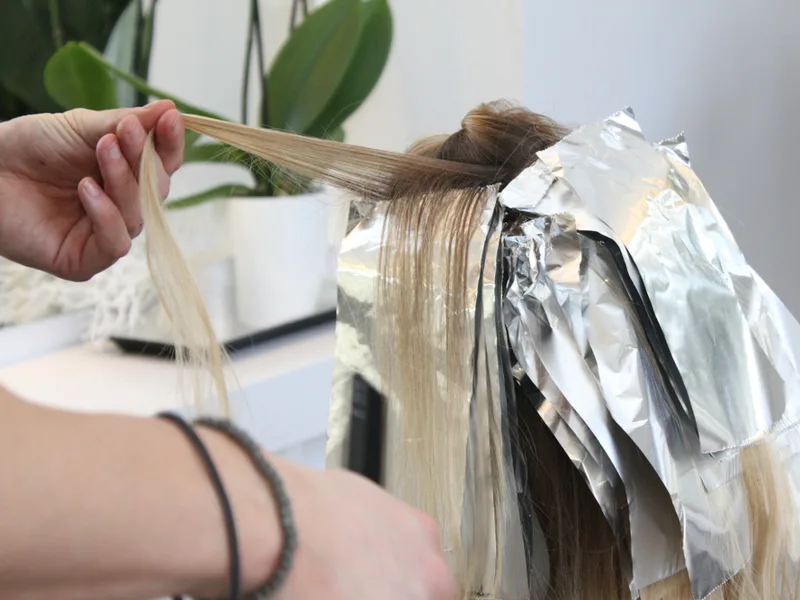Jump to:
If you’re ready to jump on the balayage train but currently have highlights, it’s likely got you thinking—can you go from highlights to Balayage? Yes, you can, and we’ll show you how. Read on to learn all you need to know.
What Is Balayage, and Can You Go to It From Highlights?
Balayage is the process of giving hair a natural, multi-dimensional color starting away from the roots, which is why you can go to it when you let your highlights grow out some. In this article, we’ll cover:
- How balayage works
- Picking the right color tone
- How to balayage hair
- Tips before taking the plunge
Given that balayage is a more advanced coloring technique, it’s crucial to understand how the process works so you can equip yourself to find the best-fit hairstylist. Read on to learn about must-know details of going from highlights to balayage.
Read Next: Balayage vs. Highlights
How Balayage Works

Hedgehog94/Shutterstock
Balayage is French for “sweeping,” and that’s what balayage hair works to achieve, given that hairstylists achieve this effect by sweeping a brush over select hair strands. It gained popularity in 2014 and continues to be a favorite option for people looking for a lower-maintenance color style.
Balayage is similar to highlights, except that the color starts away from the roots and contains more natural hair. As a result, your hair will have a more sun-kissed and authentic appearance than highlighted hair.
The Benefits of Balayage for Highlighted Hair
By choosing to transition your hair from highlights to balayage, you’ll receive numerous benefits, including:
- A gradual, natural-looking color transition
- Multiple-tone colors, adding dimension
- Easier to tone since you have a base
- Less upkeep, meaning you’ll save money
- Healthier for your scalp
Having less upkeep is one of the biggest reasons people choose to transition from highlights to balayage. Whereas it’s clear when highlights are overdue for touchups, such a time crunch doesn’t exist for balayage—it doesn’t contain harsh color lines, so you can let it grow out without embarrassment.
Furthermore, highlighted hair is often easier to transform to balayage because some of your hair already has a bleached base.
The bleach used in highlights can cause scalp irritation or even scalp burns. So, you’ll get to avoid this uncomfortable situation by using the balayage technique. For this reason, it’s a popular choice for people with skin sensitivities.
Disadvantages of Balayage
Of course, nothing is perfect. So, below are some areas to consider when deciding whether to transition your highlighted hair to balayage.
- Depending on the color you start with, it can take a few tries to get your hair light enough
- If you have dark hair, balayage may turn out a reddish color
- Not ideal for covering grey hair
One of the biggest factors we recommend you consider when deciding whether to go balayage is how natural you want your hair to look. Whereas balayage offers a sun-kissed glow, highlights are a bolder statement.
What Techniques Can You Use for Balayaging?
Since you’re already familiar with highlights, you likely know that there are several methods to apply them, including:
- Cap
- Comb
- Paper
Similarly, salon professionals can use these same techniques for balayage, given that highlights and balayage share many similarities. Furthermore, like highlights, you can choose from a range of colors.
So, although many people choose balayage for a natural look, you can spice things up with streaks of pink, blue, and other colors.
Preparing Your Hair for Balayage
There’s little you need to do to prepare your hair for balayage other than giving your hair time to grow out. Salons recommend waiting until your highlighted roots grow out between 5 – 10 centimeters before attempting balayage.
That way, they’ll have enough workspace to adjust your highlights so that they gradually fade into your natural hair color.
You Might Also Like:
- Highlights vs. Single-Process Hair Color
- Average Hair Highlights Cost
- How to Keep Highlighted Hair Healthy
Picking the Right Balayage Tone

Parilov/Shutterstock
Now that you know the answer to “Can you go from highlights to Balayage?” is “yes,” you need to figure out what colors to use. If you’re unsure, check with your stylist—they’ll offer suggestions on what would look best based on your natural hair color and current, grown-out highlights.
Balayage for Brown Hair
If you have brown hair, using a honey color is an excellent way to accent your natural tone. It’ll also give your hair the glow as if you just came back from a beach vacation in the sun.
Balayage for Black Hair
Balayage offers black hair a beautiful tone and dimension. Many people opt for shades of brown or honey to create natural-looking hints of lighter strands within their black hair. Alternatively, including deep purple or red tones can offer an attractive appearance.
Balayage for Blonde Hair
Many shades of blonde exist, and almost all blondes can benefit from balayage. Your stylist will work with your natural blonde colors to bring out an even brighter, sun-kissed appearance towards the lower part of your hair. Alternatively, you can try contrasting balayage.
Contrasting Balayage
Regardless of your hair color, you can opt for a reverse balayage look. In this case, your stylist will use darker colors at the roots before fading out the color. As a result, contrasting (or reverse) balayage is an excellent fit for people looking to make a bolder statement.
How to Balayage Hair

Tetiana Tychynska/Shutterstock
Unlike dying, hair balayage isn’t something that most people can do on their own (or at least do effectively on their own). So, although you probably won’t be transitioning your highlights to balayage yourself, the process below will help you understand what to expect.
Step 1: Melt the Foil Line
As we mentioned earlier, one of the most noticeable differences between balayage and highlights is that when highlights grow out, they form a stark line where you can see the end of the highlighted color.
Therefore, your hairstylist will need to smooth out this line in a process called melting the foil line. They’ll begin by picking an almost identical color to your natural color. Then, they’ll work that color into your hair, focusing around the highlighted line.
When you leave the salon after they melt the foil line, your hair will have a semi-balayage appearance. However, don’t despair because making the transition from highlights to balayage typically takes at least two salon visits.
Step 2: Balayage the Hair
That’s right—your hair stylists won’t even be giving you a true balayage in the first step. Instead, the second appointment is where the magic happens.
At this time, they’ll work on blending colors into your hair to give it a soft, beautifully transitioning appearance. You can expect them to use a few different colors to bring out different tones, which will help offer your hair a natural look.
Optional Step: Root Smudge
Root smudge is the term for blurring the lines between the roots of your hair and the lighter color of your hair growing out from it. So, if you return to the salon shortly after they melt the foil line, you won’t have to worry about a root smudge.
However, if enough time passes where your roots grow out past a good starting point for balayage, your hairstylist will likely suggest a root smudge. We recommend taking them up on this offer if they suggest it, given that it’ll maximize the blended appearance you want.
Tips for Transitioning From Balayage to Highlights
Making the choice to move from highlights to balayage isn’t one to take lightly. So, below are some items to consider before you take the leap.
Bring a Photo to the Salon
Hairstylists love it when their clients bring them photos of the color and look they’re going for. Not only will that help them ensure you get the balayage appearance you want, but it also opens the opportunity for comments.
For example, you might show them a balayage photo that they don’t believe would mesh well with your natural color and highlights. Or, they might set your expectations for a longer (and more expensive) process to achieve the look in the photo.
Choose an Experienced Hair Stylist
Helping someone transition from highlights to balayage takes skill. Therefore, you shouldn’t go to any old hair salon and take the first appointment with any hairdresser you can get.
Instead, ensure your hairstylist has experience in adjusting their clients’ hair from highlights to balayage. Furthermore, ask them if they have photos of some of their work—the visual will give you a feel for the accuracy of what they tell you.
Prepare for Multiple Salon Visits
Everyone enters a salon with a unique set of highlights and natural hair color. So, if your highlights are already more natural-looking, you can expect an easier transition to balayage than if you walk in the salon with a head full of bright highlights, which can take multiple salon visits to smooth out.
Furthermore, the amount of time that’s passed since you last had highlights will also make a difference, as the sun and other environmental factors can cause the highlights to oxidize and take on a brassier color that needs treating.
Frequently Asked Questions

Samoli/Shutterstock
Do you still have other questions aside from “Can you go from highlights to Balayage?” If so, read on for details.
Can you go from blonde to brown balayage?
Yes, you can go from blonde to brown balayage in a process called contrasting or reverse balayage. It’s an excellent option for people who are afraid to dye their hair brown so that they can get a feel for how brown colors look on them.
Can I balayage my own hair?
While it’s possible to balayage your own hair by using a balayage color kit, we don’t recommend it. That’s especially the case if you’re going from highlights to balayage, given that you need to melt the foil line before embarking on the balayage process.
What’s the difference between ombré and balayage?
Ombre is similar to balayage in the sense that it creates a two-tone appearance. However, it has a much starker contrast, with the bottom half of hair having a significantly lighter color than balayage. In contrast, balayage offers multi-dimensional, sun-kissed color tones.
How much does it cost to go from highlights to balayage?
You can expect it to cost anywhere from $70 – $250 to go from highlights to balayage. The pricing varies due to the salon’s location, your hair’s length, and whether your salon stylist is a well-known, experienced professional.
Which lasts longer balayage or highlights?
Balayage lasts longer than highlights because it doesn’t create the stark foil line that highlights do. In most cases, people can rock their balayage for 3 – 4 months without a touch-up. In contrast, people with highlights need to visit the salon every 6 – 8 weeks.
So, What Is Balayage, and Can You Go to It From Highlights?
Balayage works with your hair to offer it natural-looking, sun-kissed accents. Once you know how to time your highlights, going to balayage is a wonderful and relatively easy transition.
